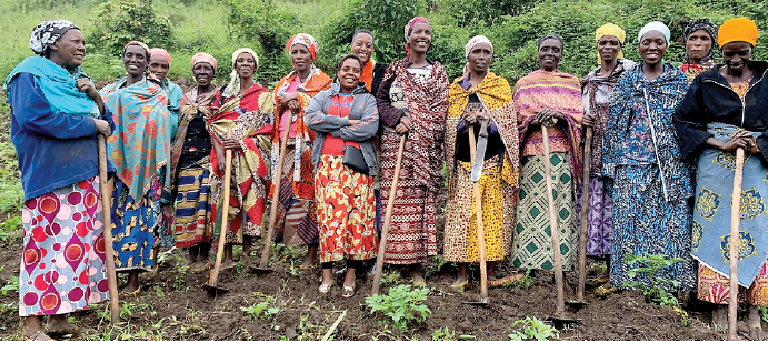Women’s inclusion in forest governance below expectation

Three decades after the landmark Beijing Declaration, the promise of gender equality remains unfulfilled for indigenous, afro-descendant and local community women who rely on forests for their livelihoods.
According to the report dubbed Resilience and Resistance by the Rights and Resources Initiative (RRI), despite comprising half of the 2.5 billion indigenous and rural people who depend on collectively held lands and forests, women continue to face systemic legal and institutional discrimination. As of 2024, only five per cent of legal frameworks regulating community forest tenure adequately protect women’s leadership rights. While these women play a crucial role in food security, biodiversity conservation and climate action, their exclusion from decision-making processes threatens not only their own well-being but also the sustainability of the world’s remaining forests.
“Since 2016, progress in recognition of community women’s forest tenure rights is inconsistent and marginal, even in legal frameworks recognising their communities’ forest ownership. Among the 12 conservation-oriented legal frameworks that underwent reforms between 2016 and 2024, no advancements were made in protecting community women’s specific rights,” reads part of the report.
Stagnanted progress
The report’s findings expose a troubling gap between international commitments and actual implementation. All 35 countries examined in the study spanning Africa, Asia, and Latin America have ratified the UN Convention on the Elimination of All Forms of Discrimination against Women (CEDAW). However, not a single country has fully met its obligations to protect women’s community-based rights to membership, governance, inheritance and dispute resolution.
The stagnation is particularly evident in legal protections for land ownership and tenure rights. While most countries recognise women’s constitutional equality and property rights, only 11 out of 35 uphold their intestate inheritance rights. Moreover, gender-blind legislation in forest governance has exacerbated disparities, with only two per cent of legal frameworks protecting women’s voting rights and five per cent recognising their leadership roles within community forests.
Meeting equality objectives
“While all examined countries have ratified the CEDAW, no country is remotely close to meeting their legal obligations to protect women’s community-based rights to membership, governance, inheritance and dispute resolution rights,” says Dr. Solange Bandiaky-Badji, RRI Coordinator.
Solange adds “With less than five years to achieve the UN’s 2030 Agenda for Sustainable Development Goals (SDGs), the limited progress observed between 2016 and 2024 shows that governments are unlikely to meet gender equality objectives by 2030 if they don’t undertake gender-transformative actions to ensure compliance with international human rights standards.”
According to her, countries’ overall progress on SDG 5 on gender equality, obligations under CEDAW, and the Beijing Declaration is alarmingly low. Not a single SDG 5 indicator is on track to be achieved by 2030, including the one on women’s equal control and ownership of land. Africa, Asia and Latin America are far from meeting their goals, with weak legal protections for women’s land rights, limited inclusion in climate policies, and persistent gender-based violence.
The report reveals that most of the laws that specifically regulate community-level tenure rights fail to protect women’s rights within communities adequately. This is why among the 97 legal frameworks recognised as of 2016 and the 104 legal frameworks recognised as of 2024, the proportion that has adequate protections for women’s rights has remained stagnant at two per cent for voting rights, five per cent for leadership, and 13 per cent for inheritance.
Gender-blind legislations
“Countries in Africa have made the most legal reforms since 2016, yet they exhibit the lowest degree of progress for women’s forest tenure rights. Alarmingly, Africa remains the only region where no legal framework adequately protects women’s rights to vote within their communities. Latin America and Asia fare slightly better but still fall short of achieving gender equity in community-based land tenure,” she says.
According to the report, the legal advancement of women and their communities goes hand in hand. However, the widespread use of gender-blind legislations to regulate community forest tenure may be widening the gap between women’s forest rights and their communities’ collective forest rights. Governments must align national policies with international commitments, ensuring that land reforms explicitly protect women’s rights to governance, inheritance and decision-making.
Furthermore, increased investment in women-led conservation and climate initiatives is critical.
Women inclusion
“Science shows that when our communities have strong rights and protections to our ancestral lands, we protect natural ecosystems better than anyone else. Our rights must be central to global efforts to protect Earth’s climate and biodiversity,” says Gam Shimray, Indigenous Naga leader and Secretary-General of RRI partner, Asia Indigenous Peoples Pact (AIPP).
Apart from that, Stanley Kimaren Ole Riamit, Maasai leader and President, of Indigenous Livelihoods Enhancement Partners (ILEPA) says that if companies and investors are to meaningfully and sustainably contribute to global development goals and comply with their own sustainability and human rights commitments and obligations, they must prioritise building respectful direct and balanced partnerships with indigenous people and local communities impacted by their projects.
According to him, the leadership role of women and girls in conservation efforts must also be recognised, as they play a crucial role in preserving biodiversity and protecting natural ecosystems. He emphasises that nature cannot be saved unless Indigenous, Afro-descendant, and rural women are placed at the center of these efforts, given their deep-rooted knowledge, sustainable practices, and active participation in environmental stewardship.












